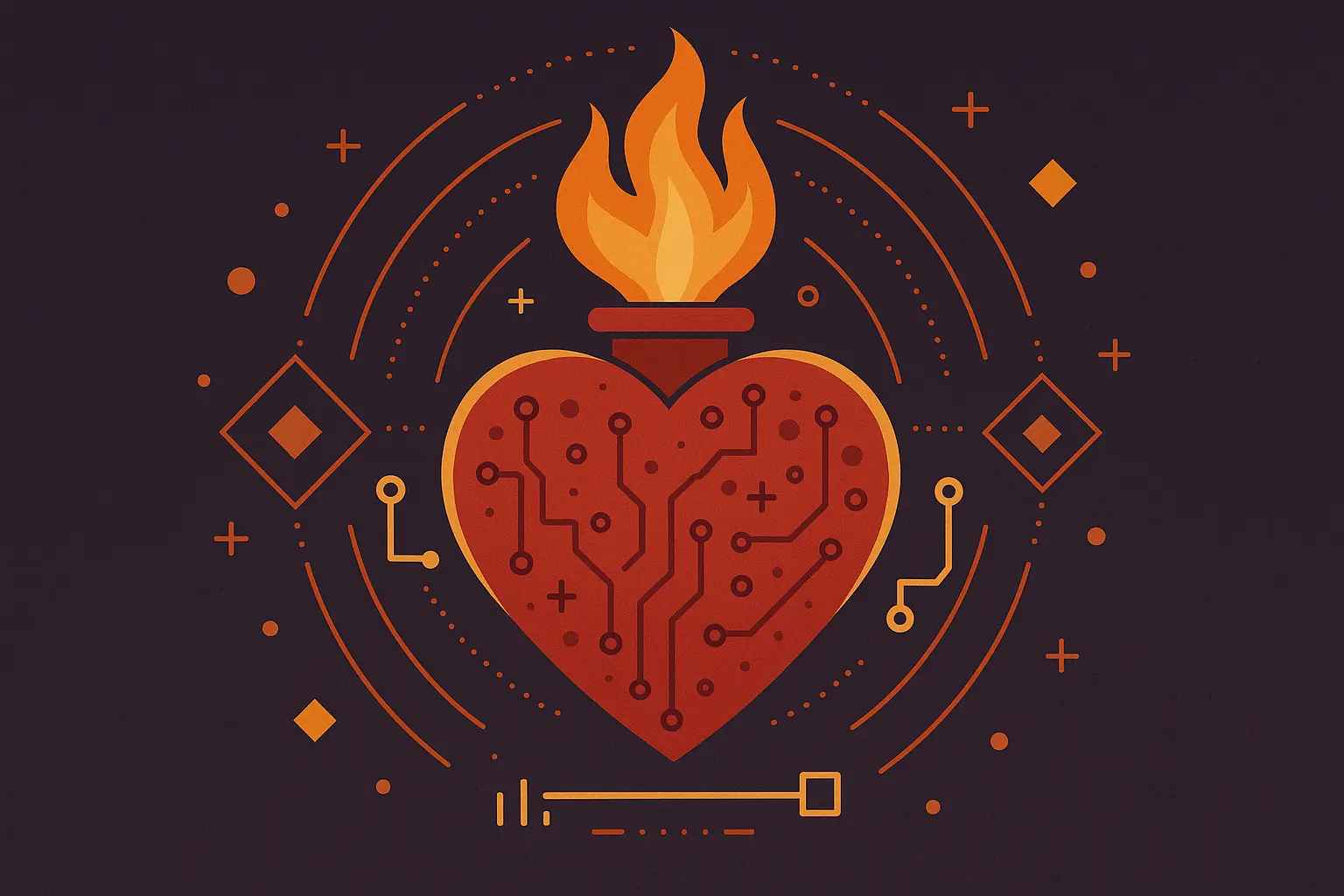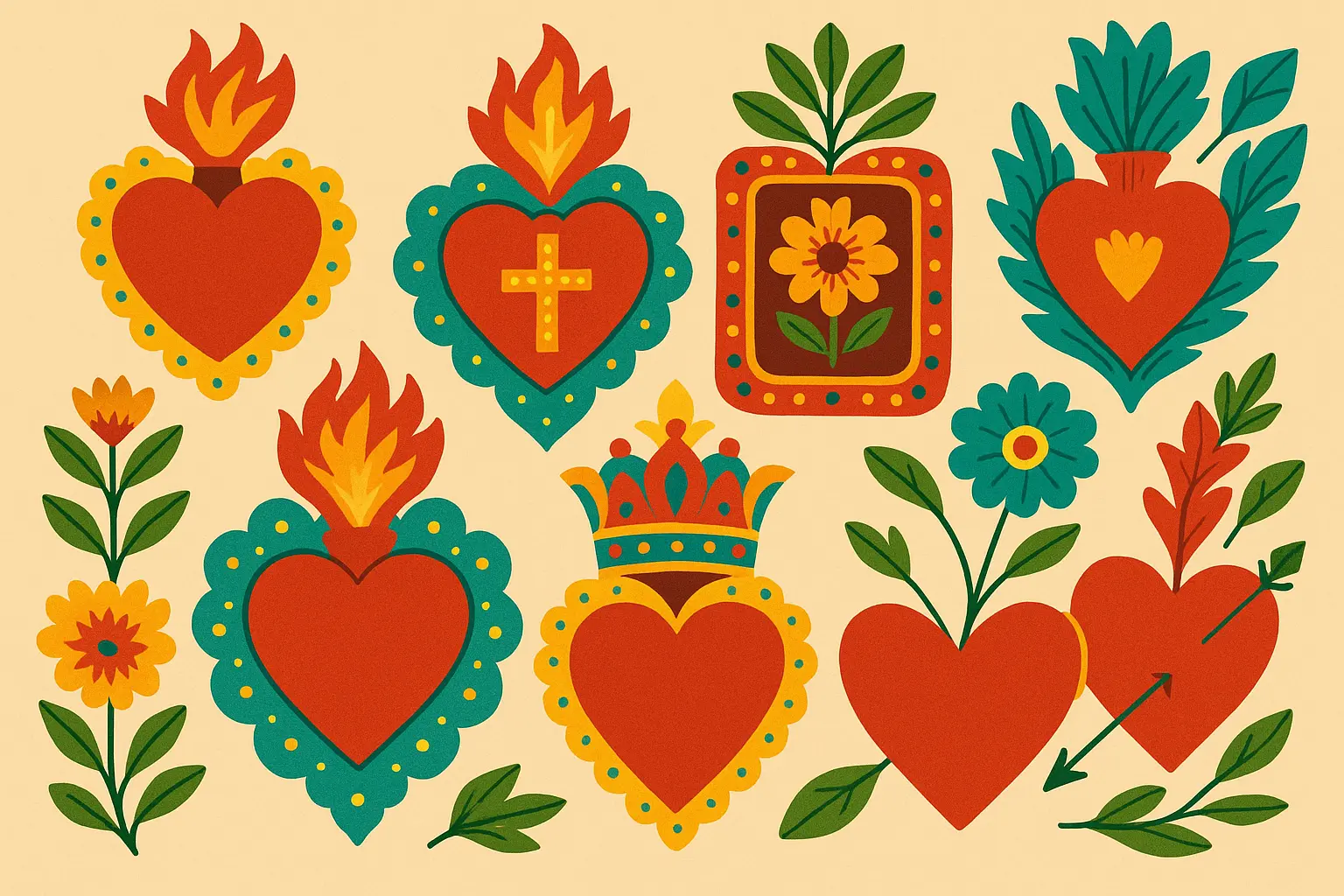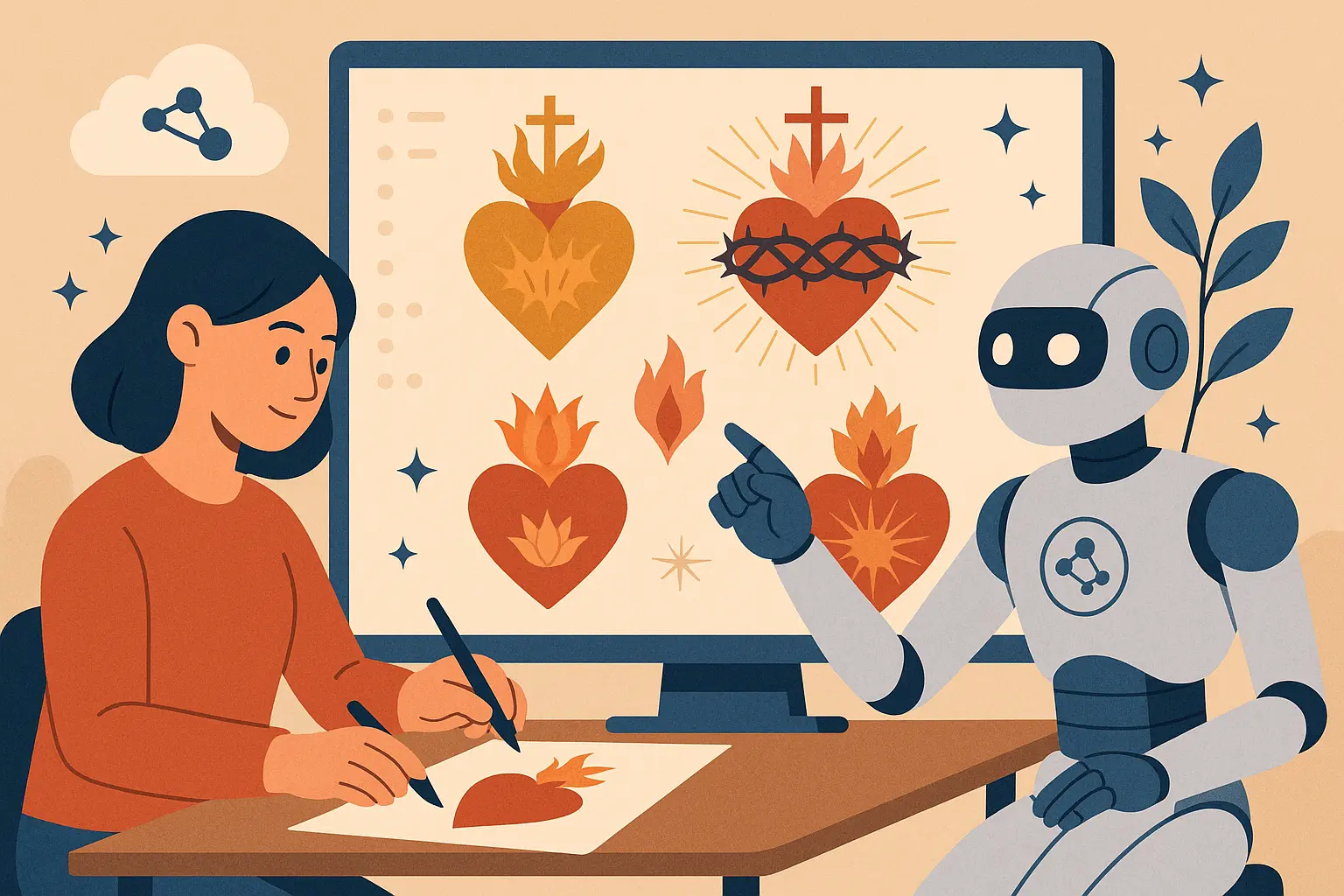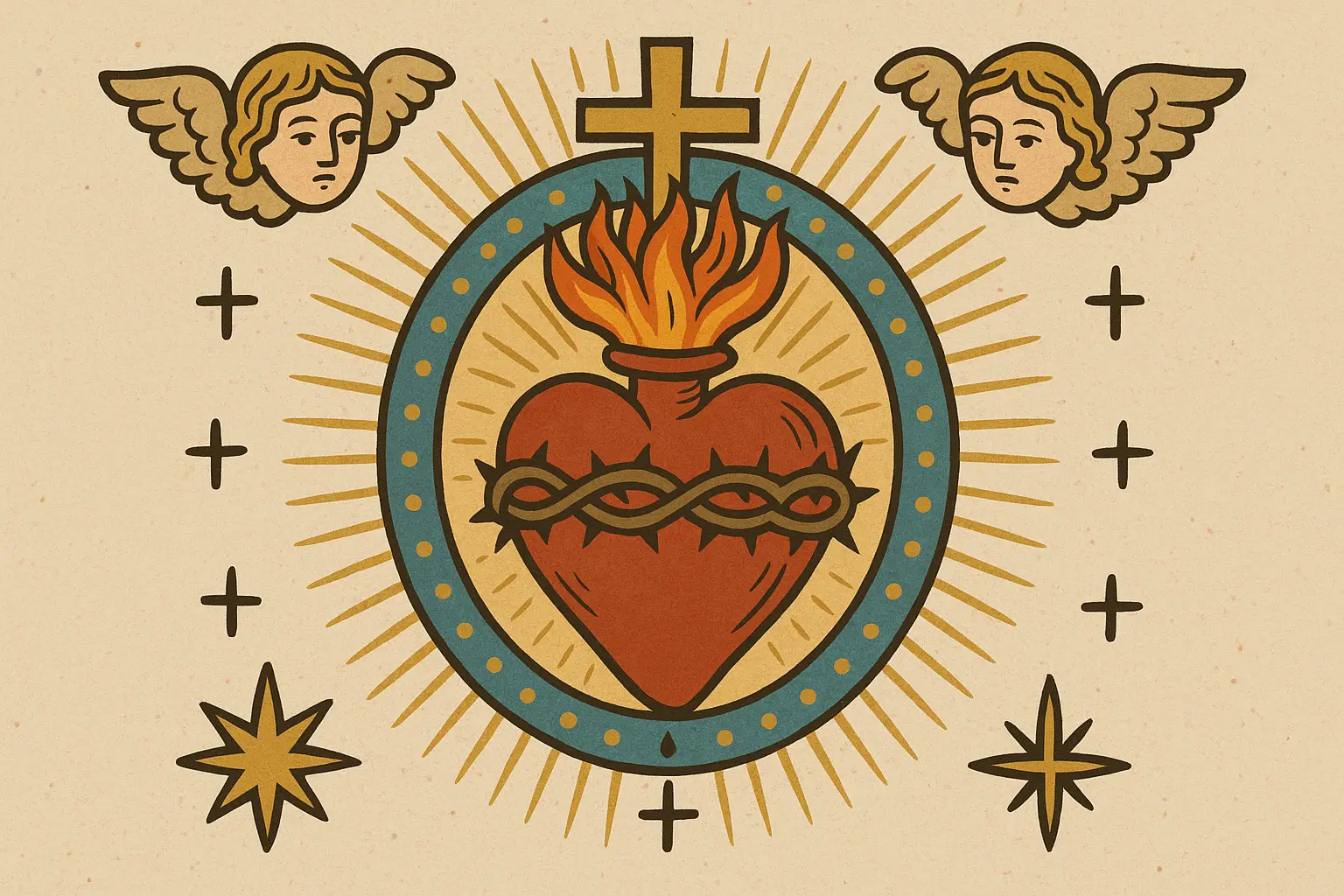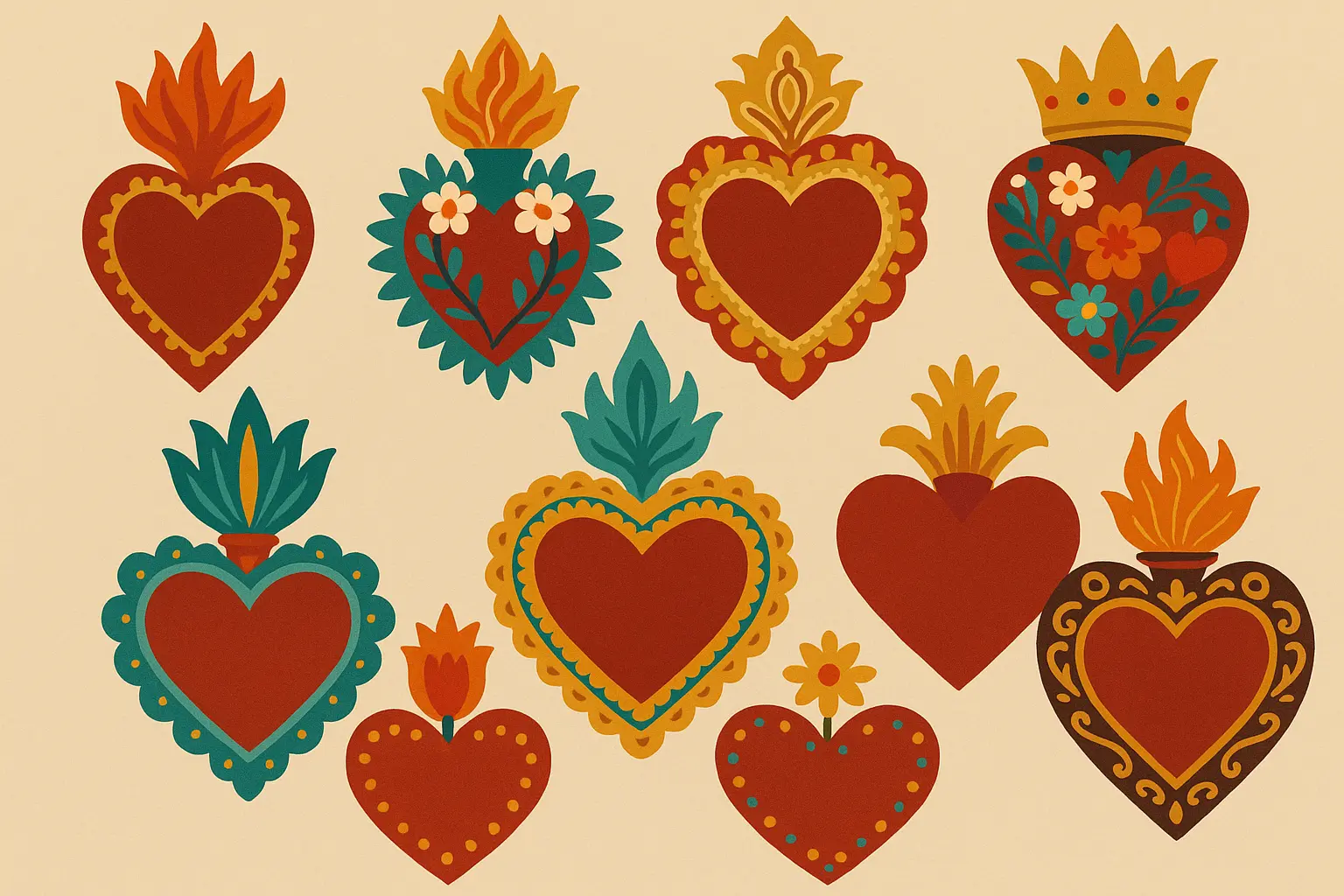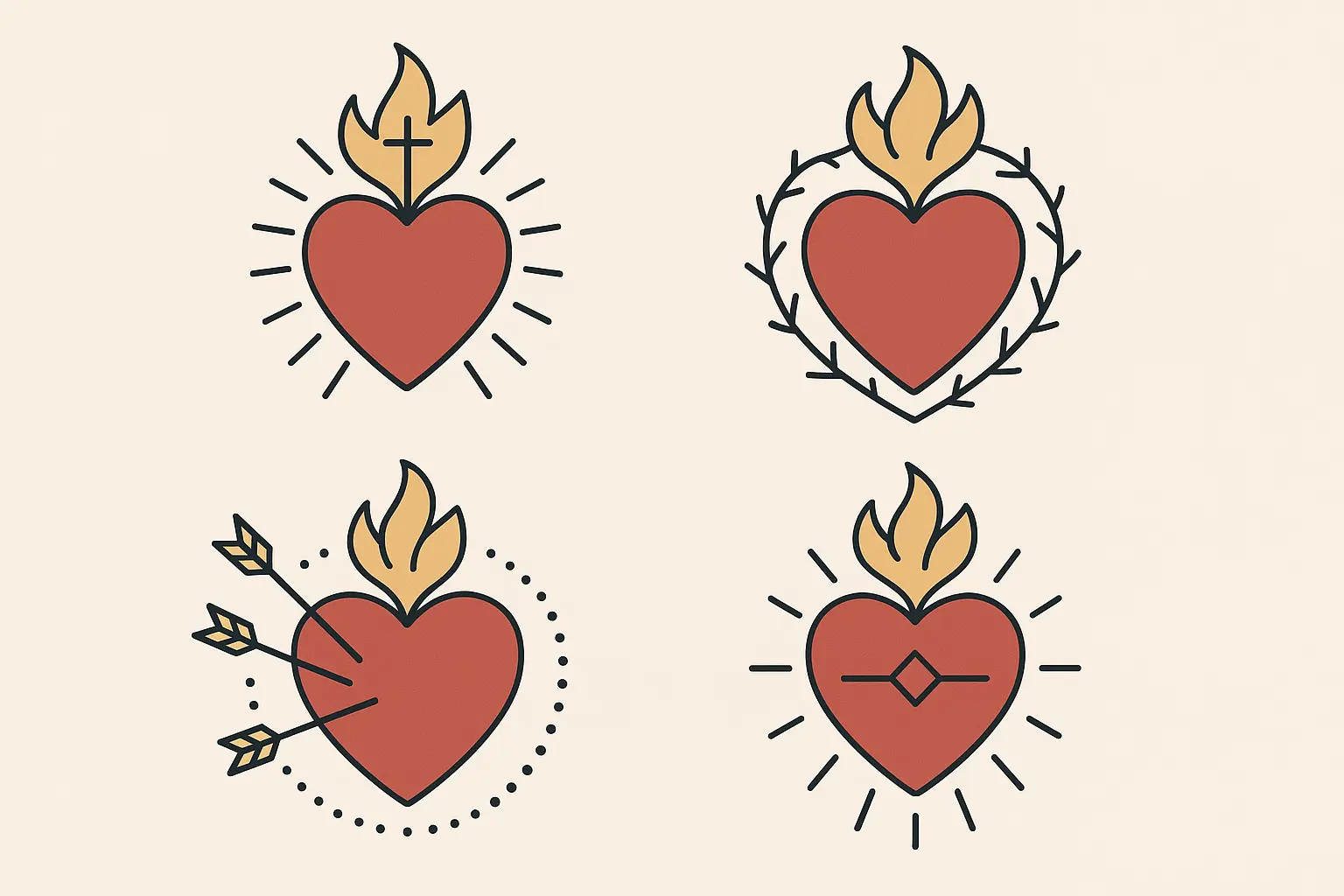Sacred Heart Tattoo Meaning: Why This Ancient Symbol Is Becoming Everyone’s Most Personal Ink Choice
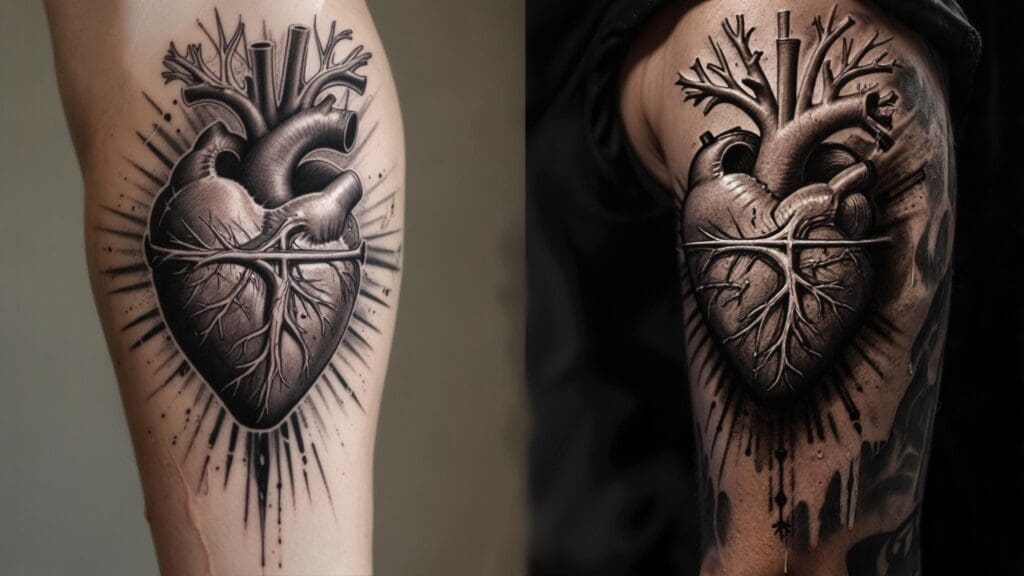
The sacred heart has evolved from its 17th-century Catholic origins into one of today’s most meaningful tattoo choices, with the devotion to the Sacred Heart of Jesus becoming somewhat well-known inside the Roman Catholicism, particularly from the 17th century onward according to religious historians. What started as visions from Saint Margaret Mary Alacoque has transformed into a powerful symbol that transcends religious boundaries, speaking to universal themes of love, sacrifice, and spiritual transformation.
Table of Contents
-
The Digital Revolution of Sacred Ink
-
What Your Sacred Heart Tattoo Really Says About Your Inner Journey
-
The Underground Networks Keeping Sacred Traditions Alive
-
Getting Your Sacred Heart Design Right in the AI Age
-
From Medieval Mystics to Modern Minimalism: Style Evolution Decoded
TL;DR
-
Sacred heart tattoos have evolved way beyond traditional Catholic imagery – now they’re deeply personal spiritual statements that mix ancient meaning with modern self-expression
-
AI tattoo generators are changing how we create sacred heart designs, but they need to actually understand what makes something sacred (not just pretty)
-
People today use sacred heart tattoos for healing trauma, showing their spiritual side, and turning vulnerability into strength
-
These tattoos create unexpected connections between people from totally different backgrounds who share similar values
-
Modern styles range from bold neo-traditional pieces to super minimal designs, but they all keep the spiritual core intact
-
Creating a good sacred heart tattoo means balancing cool technology with genuine respect for what the symbol actually means
The Digital Revolution of Sacred Ink
Sacred heart tattoos are going through a massive transformation right now, and honestly, it’s pretty incredible to watch. This ancient symbol is moving way beyond its traditional religious roots and becoming something much more personal and cutting-edge. We’re talking about centuries-old imagery getting a complete digital makeover while still honoring what makes it spiritually meaningful.
I’ve been watching this evolution happen, and what really gets me is how people are taking this sacred heart imagery that’s been around forever and making it completely their own. Sure, you’ve still got the traditional flames, thorns, and radiating light, but now they’re being reimagined with digital tools that would blow the minds of the mystics who first saw these visions.
How AI Is Reimagining Divine Imagery
Modern AI tattoo generators are completely flipping the script on how we approach sacred heart designs, but here’s the thing – this technology needs to actually understand religious symbolism and cultural sensitivity. We’re not just talking about creating pretty pictures here. We’re talking about maintaining the spiritual reverence that makes these symbols meaningful instead of just decorative.
This is uncharted territory. We’re literally teaching machines to understand sacred heart symbolism in ways that go way deeper than just recognizing patterns. The AI has to figure out the difference between a cute Valentine’s Day heart and a symbol that represents divine love, sacrifice, and spiritual transformation. That’s not exactly simple programming.
Teaching Machines About Sacred Geometry
AI systems have to process incredibly complex visual elements – anatomically correct hearts, flame symbolism, crown of thorns placement, radiating light patterns. But the real challenge? Programming these systems to understand that sacred heart imagery carries spiritual weight that goes way beyond simple romantic or decorative hearts.
Getting this right means the AI needs to understand that we’re not talking about shapes and colors here – we’re talking about meaning. Deep, centuries-old, life-changing meaning.
Sacred geometric designs play off motifs found in both nature and religion, becoming a beautiful amalgamation that shines a light on any area chosen to be inked, large or small Fashion Beans reports, highlighting how modern geometric approaches are revolutionizing traditional sacred imagery.
Understanding the deeper symbolism behind sacred heart designs becomes even more important when exploring spiritual tattoo ideas that honor both tradition and personal meaning. The sacred heart isn’t just about the visual elements – it’s about connecting with something bigger than yourself.
Training Algorithms on Centuries of Faith
Basically, we’re showing computers thousands of pictures – everything from old prayer cards your grandma might have had to modern tattoo photos – so they can learn what makes a sacred heart actually look sacred. We’re feeding machines cultural context, which is way more complex than just showing them pretty pictures.
The training process involves exposing AI systems to massive collections of Catholic art, folk traditions, and contemporary interpretations. Each image carries cultural DNA that the system needs to understand and respect. It’s like teaching a computer about your family history – there are layers of meaning that go way beyond what you can see on the surface.
|
Sacred Heart Element |
Traditional Meaning |
AI Training Challenge |
|---|---|---|
|
Flames |
Divine love, Holy Spirit presence |
Teaching computers the difference between holy flames and cartoon fire |
|
Crown of Thorns |
Christ’s suffering, sacrifice |
Making sure it doesn’t look like barbed wire from a prison movie |
|
Radiating Light |
Divine grace, enlightenment |
Creating authentic spiritual glow, not laser beams |
|
Anatomical Heart |
Physical reality of divine love |
Balancing medical accuracy with spiritual symbolism |
|
Blood Drops |
Life given in sacrifice |
Representing holiness, not violence |
The Authenticity Challenge in Digital Design
Programming AI to distinguish between sacred and secular heart imagery involves teaching computers to understand spiritual significance, not just copy visual patterns. The system has to recognize when a heart design carries religious meaning versus when it’s just decoration. We’re teaching a computer the difference between a cross as a spiritual symbol and a cross as a geometric shape – context changes everything.
This is where it gets really tricky. How do you program a machine to recognize the sacred? It’s like trying to teach someone who’s never felt love to recognize it in a photograph. The technology is getting there, but it’s not simple.
How Modern People Are Redefining Sacred Symbols
Here’s what’s really fascinating – people today are taking sacred heart imagery and mixing it with their own spiritual understanding. Contemporary sacred heart tattoos blend traditional Catholic imagery with personal spiritual journeys, secular symbolism, and artistic movements. This creates hybrid meanings that reflect individual faith experiences rather than just following institutional religious doctrine.
I’ve seen designs that incorporate Buddhist elements, indigenous symbols, or completely secular representations of love and compassion. The Catholic foundation is still there, but people are building on it in ways that would probably surprise the original mystics.
Post-Religious Spirituality Takes the Wheel
Many people today adopt sacred heart imagery as a symbol of universal love, emotional healing, or spiritual awakening that’s completely divorced from specific Catholic doctrine. They’re transforming this ancient symbol into something that represents heart-centered consciousness in a broader sense.
I’ve seen people use sacred heart designs to represent their journey through addiction recovery, their commitment to compassion, or their belief in love as a transformative force. The Catholic origins matter, but the personal meaning they create matters more. This approach lets people connect with the symbol’s power without necessarily embracing its traditional religious baggage.
Women Reclaiming Divine Feminine Power
Women are increasingly taking back sacred heart imagery as a symbol of divine feminine power, maternal strength, and emotional sovereignty. They often add elements like flowers, moon phases, or goddess imagery to create distinctly feminine spiritual statements.
This is about taking a symbol that was traditionally male-dominated (think Jesus’s sacred heart) and infusing it with feminine energy and power. It’s about claiming spiritual authority on their own terms. These designs become declarations of feminine spiritual independence – and they’re absolutely beautiful.
What Your Sacred Heart Tattoo Really Says About Your Inner Journey
Let’s be honest – when someone chooses a sacred heart tattoo, they’re not just picking out a pretty design. The psychological reasons behind choosing sacred heart tattoos reveal how people use these symbols for trauma healing, spiritual seeking, cultural identity, and the very human need for visible symbols of inner transformation. These aren’t decorative pieces – they’re deeply personal statements about someone’s spiritual and emotional journey.
When someone gets a sacred heart tattoo, they’re making a statement that goes way beyond aesthetics. They’re declaring something about their relationship with love, pain, healing, and the sacred. The meaning becomes deeply intertwined with their personal story.
Sacred Symbols as Healing Tools
Sacred heart tattoos often serve as powerful markers of spiritual healing journeys, representing the transformation of emotional wounds into sources of compassion, strength, and divine connection. The tattoo becomes a visible commitment to personal growth and spiritual evolution.
Many people find that sacred heart designs work perfectly alongside other meaningful tattoo ideas that represent their personal transformation and healing journey. The sacred heart becomes part of a larger story written on their skin.
Your Body as a Canvas for Healing
Getting a sacred heart tattooed can feel like taking back control of your own story, especially if you’ve been through hell and back. The physical act of tattooing sacred heart imagery can serve as a ritual of reclaiming bodily autonomy and spiritual agency, particularly for trauma survivors. The symbol represents their heart’s resilience and capacity for healing, literally written on their skin.
The pain of the tattoo process itself becomes part of the healing ritual. You’re taking something that hurt you and transforming it into something sacred. It’s powerful stuff.
Sarah, a trauma survivor, chose to get a sacred heart tattoo over her mastectomy scar. She incorporated roses for healing and flames for her renewed passion for life. The tattoo transformed a source of pain into a symbol of her strength and spiritual resilience. When she looks in the mirror now, she sees strength instead of loss.
Turning Vulnerability into Strength
Displaying a sacred heart tattoo represents a conscious choice to wear your spiritual journey where everyone can see it, transforming private devotion into public testimony of faith, healing, or commitment to love despite life’s challenges.
There’s something incredibly brave about putting your spiritual beliefs on your skin where everyone can see them. You’re saying, “This is who I am, and I’m not hiding it.” That vulnerability becomes a form of strength. The tattoo becomes armor made of openness.
Building Identity Through Sacred Imagery
The choice to permanently mark your body with sacred heart symbolism reflects deep psychological needs for spiritual identity, community belonging, and creating meaning through visual storytelling on human skin.
Sacred heart tattoos become part of identity formation in ways that surprise people. The symbol becomes part of how they see themselves and how they want the world to see them.
Bridging Generations Through Ink
Many sacred heart tattoos serve as bridges between family spiritual traditions and personal faith evolution. You might get a sacred heart tattoo that honors your grandmother’s devotion while also representing your own spiritual journey that looks nothing like traditional Catholicism. It’s about honoring the past while claiming your own path. The tattoo becomes a conversation between generations.
I’ve met people who got their sacred heart tattoo in the exact style their grandfather had, and others who took the basic symbol and made it completely their own. Both approaches honor family heritage while allowing for personal expression.
Finding Your Tribe Through Symbols
Here’s the cool thing – people with sacred heart tattoos kind of find each other. It doesn’t matter if you’re Catholic, spiritual-but-not-religious, or somewhere in between. There’s this unspoken understanding. Within certain communities – from traditional Catholic families to alternative spiritual circles to tattoo culture itself – sacred heart imagery functions as a visual language of shared values, spiritual seeking, and commitment to heart-centered living.
When you see someone else with a sacred heart tattoo, there’s often an instant recognition. You might not share the same specific beliefs, but you both understand the weight of wearing your spirituality on your skin. These connections create unexpected bonds between strangers.
Spiritual Therapy Through Permanent Art
Sometimes getting a sacred heart tattoo is about taking back power from religious institutions that hurt you. The process of choosing, designing, and receiving a sacred heart tattoo often serves as a form of spiritual therapy, helping people process religious trauma, reclaim spiritual agency, and create new relationships with divine imagery on their own terms.
You’re saying, “This symbol means something to me, and I get to decide what that is.” The tattoo becomes an act of spiritual rebellion and reclamation. It’s therapy you can see.
Sacred Heart Tattoo Planning Checklist:
-
Research the symbol’s traditional meanings and cultural significance
-
Reflect on your personal connection to the imagery
-
Consider placement and visibility preferences
-
Choose elements that represent your spiritual journey
-
Find an artist experienced with religious iconography
-
Discuss cultural sensitivity with your tattoo artist
-
Plan for proper aftercare and healing time
The Underground Networks Keeping Sacred Traditions Alive
Sacred heart tattoos operate within cultural networks that transmit meaning across religious boundaries, artistic movements, and generational lines. These create underground systems of spiritual communication and cultural preservation that extend way beyond traditional Catholic contexts.
We’re talking about something that functions almost like a secret society of spiritual seekers. People with sacred heart tattoos often find each other in unexpected places, creating connections that transcend traditional religious or cultural boundaries. These networks preserve and transmit spiritual knowledge in ways that formal institutions sometimes can’t.
Folk Art Living On Through Skin
Sacred heart tattoos serve as living repositories of folk artistic traditions, preserving visual languages of devotion, cultural memory, and spiritual expression that might otherwise disappear in increasingly secular societies.
Carrying Home Across Borders
For immigrant communities, sacred heart tattoos often function as portable homeland markers. When you can’t take your grandmother’s altar with you to a new country, you can carry the sacred heart on your skin. It becomes a way of keeping your cultural identity alive in a foreign place, carrying cultural and spiritual DNA across borders while adapting to new cultural contexts and maintaining connection to ancestral spiritual practices. The tattoo becomes a portable shrine.
As documented by photographer Delilah Montoya in her “Sagrado Corazón/Sacred Heart” project, “Within the Chicano community, the Sacred Heart functions as a religious icon as well as a pop reproduction. The heart is tattooed on the arms of working class youth” Nieman Reports, demonstrating how sacred imagery adapts across cultural contexts.
This cultural transmission often intersects with Christian tattoo ideas that blend traditional iconography with contemporary cultural expression.
Secret Spiritual Languages
In contexts where traditional religious expression faces restrictions or cultural pressure, sacred heart tattoos provide covert methods of maintaining spiritual identity and community recognition. Sometimes sacred heart tattoos become a way of finding other people who share your spiritual understanding without having to announce it to the world. The symbol functions as a secret handshake for the spiritually inclined.
It’s like having a spiritual password that only certain people recognize. The tattoo operates as coded visual language that flies under mainstream cultural radar while connecting like-minded souls.
Building Bridges Between Different Faiths
Modern sacred heart tattoo culture creates unexpected bridges between different spiritual communities, fostering dialogue and synthesis between Catholic mysticism, indigenous spirituality, New Age practices, and secular humanistic values through shared symbolic vocabulary.
Universal Symbols in Diverse Contexts
Sacred heart imagery increasingly appears in interfaith spiritual contexts. I’ve seen Buddhist practitioners incorporate sacred heart imagery into their tattoos alongside lotus flowers and dharma wheels. The symbol transcends its Catholic origins to represent something universal about love and compassion. Practitioners from Buddhist, Hindu, Indigenous, and eclectic spiritual backgrounds are adopting and adapting the symbol to represent universal themes of compassion, divine love, and heart-centered consciousness.
Maria, a practitioner of both Catholicism and indigenous Mexican traditions, designed a sacred heart tattoo that incorporated Aztec sun imagery with traditional Catholic flames. The design honored both her Spanish and indigenous heritage, creating a visual representation of cultural syncretism that would make anthropologists weep with joy.
Getting Your Sacred Heart Design Right in the AI Age
Creating sacred heart tattoo designs through AI platforms requires understanding religious iconography, making sure we respect the culture behind the symbol, and dealing with the technical challenges of translating spiritual symbolism into computer programming while maintaining both artistic quality and spiritual authenticity.
We’re entering uncharted territory here. AI can generate incredible sacred heart designs, but the technology needs to understand the weight of what it’s creating. These aren’t just pretty pictures – they’re spiritual symbols that carry centuries of meaning and devotion.
Teaching AI to Respect Sacred Imagery
Developing AI systems capable of generating respectful sacred heart tattoo designs requires careful curation of training datasets, implementation of cultural sensitivity filters, and ongoing refinement to ensure outputs honor the symbol’s spiritual significance while allowing for creative interpretation.
Getting the Details Right
Teaching a computer to draw a sacred heart that actually looks sacred (not like a Valentine’s Day card) is trickier than you’d think. AI systems must be trained to recognize and accurately reproduce specific elements of sacred heart iconography – including anatomically correct heart shapes, appropriate flame styling, crown of thorns positioning, and radiating light patterns – while avoiding common misrepresentations that could diminish spiritual meaning. The difference between a flame that looks spiritual and one that looks cartoonish is huge when you’re dealing with sacred imagery. AI needs to understand these nuances. We’re programming computers to recognize the sacred, which is both fascinating and challenging.
|
Design Element |
Correct Representation |
Common AI Mistakes |
Cultural Significance |
|---|---|---|---|
|
Heart Shape |
Anatomically inspired, slightly stylized |
Too cartoon-like or geometric |
Represents Christ’s physical heart |
|
Flames |
Upward-reaching, divine quality |
Comic book fire, aggressive flames |
Holy Spirit, divine love |
|
Thorns |
Sharp but reverent, crown formation |
Barbed wire appearance |
Christ’s suffering, sacrifice |
|
Light Rays |
Gentle radiance, spiritual glow |
Harsh beams, laser-like effects |
Divine grace, enlightenment |
|
Blood |
Sacred drops, life-giving |
Violent or gory appearance |
Sacrifice, redemption |
Preventing Cultural Appropriation Through Code
The newer AI tools are getting pretty good at not creating designs that would make your Catholic grandmother cringe – but they’re still learning. Advanced AI platforms implement cultural analysis algorithms that can distinguish between respectful adaptation and inappropriate appropriation of sacred imagery, helping users create designs that honor the symbol’s heritage while expressing personal spiritual connection.
This is where technology gets really interesting – programming computers to understand cultural sensitivity and respect. We’re not just generating pretty pictures here; we’re creating respectful sacred heart designs.
Understanding these principles becomes crucial when exploring AI tattoo generators that can create culturally sensitive sacred heart designs.
Human-AI Collaboration for Sacred Design
The most effective sacred heart tattoo generation happens when you combine AI’s creative capabilities with human understanding of cultural context and spiritual meaning. Neither works perfectly alone, but together they can create something amazing. The best results involve hybrid workflows where AI provides initial concepts and variations while human designers with cultural and spiritual knowledge refine outputs to ensure cultural sensitivity, spiritual authenticity, and artistic excellence.
And let’s be real – if you’re using AI to design your tattoo, definitely run it by a human artist who knows their stuff about religious imagery. Computers are smart, but they don’t have souls (yet).
When exploring sacred heart designs, consider how they might work alongside other heart tattoo designs to create a cohesive spiritual narrative on your skin.
When you’re ready to explore sacred heart tattoo ideas that honor both tradition and personal meaning, Tattoo Generator IQ offers AI-powered tools specifically trained on religious and spiritual imagery. Our platform understands the cultural significance behind sacred symbols and helps you create designs that are both artistically stunning and spiritually authentic.
AI Sacred Heart Design Template:
-
Base Elements Selection:
-
Heart style (anatomical vs. stylized)
-
Flame configuration (single vs. multiple)
-
Crown of thorns detail level
-
-
Cultural Context Input:
-
Religious tradition (Catholic, syncretic, secular)
-
Regional folk art influences
-
Personal spiritual elements
-
-
Technical Specifications:
-
Size and placement considerations
-
Color palette preferences
-
Line weight and shading style
-
-
Sensitivity Review:
-
Cultural appropriation check
-
Religious respect verification
-
Personal meaning alignment
-
From Medieval Mystics to Modern Minimalism: Style Evolution Decoded
Traditional sacred heart tattoos represent the foundational visual language that all contemporary interpretations build from. Understanding the historical iconographic elements, artistic techniques, and cultural contexts that shaped this enduring spiritual symbol across centuries of devotional art is crucial for anyone considering this tattoo.
The evolution from medieval mysticism to modern ink tells an incredible story. We’re witnessing how a symbol born from religious visions has adapted to contemporary artistic movements while maintaining its spiritual core. The traditional sacred heart established visual codes that modern artists continue to reference and reinterpret.
The Original Sacred Heart DNA
Traditional sacred heart imagery carries specific visual codes developed through centuries of Catholic mystical art, folk devotion, and cultural transmission. This created a standardized symbolic vocabulary that modern tattoo interpretations need to understand to maintain authentic spiritual connection.
Medieval Mystics Started It All
The sacred heart symbol emerged from medieval mystical experiences, particularly those of Saint Margaret Mary Alacoque. Saint Margaret Mary’s visions in the 1600s gave us the visual language we still use today. She saw Christ’s heart surrounded by flames, crowned with thorns, and radiating light – images that became the template for centuries of sacred heart art. Her mystical experiences created the blueprint for every traditional sacred heart tattoo that followed.
These visions translated abstract spiritual concepts into concrete imagery accessible to both literate and illiterate populations. Pretty genius, actually – creating visual representations of divine love that anyone could understand and connect with.
Folk Art Kept It Alive
Traditional sacred heart imagery spread through folk art traditions, prayer cards, and domestic religious objects. Every culture that adopted the sacred heart symbol added their own artistic flair while keeping the essential elements intact. Mexican folk art, Italian devotional paintings, Irish prayer cards – they all contributed to the visual tradition we inherit today. The meaning remained consistent even as artistic styles varied dramatically across regions.
This created regional variations in artistic style while maintaining core symbolic elements that ensure universal recognition across Catholic cultures worldwide. It’s like a spiritual game of telephone that actually worked – the message stayed clear even as it traveled across continents and centuries.
How Contemporary Artists Are Mixing Old and New
Modern sacred heart tattoos increasingly blend traditional iconography with contemporary artistic movements. Artists today are taking centuries-old sacred heart imagery and pushing it through the lens of contemporary tattooing techniques. The results are stunning – designs that feel both ancient and cutting-edge simultaneously, creating hybrid aesthetic approaches that honor historical symbolism while expressing individual artistic vision and cultural context.
Neo-Traditional Gets a Spiritual Upgrade
Neo-traditional sacred heart tattoos employ modern tattooing techniques – bold outlines, saturated colors, dimensional shading – while maintaining classical compositional elements. Neo-traditional style takes the classic sacred heart and gives it that modern tattoo treatment: thicker lines, more vibrant colors, better shading techniques. The symbol stays the same, but the execution gets an upgrade. These designs pop off the skin in ways that traditional techniques couldn’t achieve, creating designs that feel both timeless and contemporary in their visual impact.
Jake’s neo-traditional sacred heart incorporates traditional flames and thorns but uses modern color saturation techniques to create depth. His artist added contemporary rose varieties around the heart while maintaining the classic crown of thorns, creating a design that honors tradition while feeling fresh and modern. The result is something his great-grandfather would recognize but would probably be amazed by the technical execution.
Less Is More: Minimalist Sacred Hearts
Sometimes the most powerful sacred heart tattoos are the simplest ones. Minimalist sacred heart designs strip away ornate traditional elements to focus on essential symbolic components – simplified heart shapes, clean flame lines, geometric crown representations. A clean heart outline with minimal flames can carry just as much spiritual weight as an elaborate traditional design. The minimalist approach forces you to focus on what’s truly essential about the symbol, creating powerful spiritual statements through visual restraint rather than elaborate decoration.
Anatomically Correct Sacred Hearts
Some contemporary artists create sacred heart tattoos using anatomically accurate heart imagery combined with traditional spiritual elements. These designs get really intense – they use actual anatomical heart shapes instead of the stylized traditional version. It’s a way of making the spiritual symbol feel more physically real and immediate. The meaning becomes more visceral when you’re looking at something that resembles an actual human heart, creating visceral representations that emphasize the physical reality of divine love incarnated in human flesh and blood.
Final Thoughts
Look, whether you’re thinking about getting a sacred heart tattoo because it reminds you of your roots, or because you’ve been through something that changed you, or just because the symbol speaks to you – that’s totally valid. Sacred heart tattoo meaning has evolved into something far more complex and personal than its traditional Catholic origins might suggest. We’re living through a fascinating time where ancient spiritual symbols are finding new life through digital technology, personal healing journeys, and cross-cultural spiritual exploration.
The important thing is that it means something real to YOU. Whether you’re drawn to the sacred heart as a connection to family heritage, a marker of personal transformation, or simply as a powerful symbol of love and compassion, the key is understanding both its historical significance and your own personal relationship with the imagery. The best sacred heart tattoos honor the symbol’s spiritual weight while expressing something authentic about your own journey.
The intersection of AI technology and sacred imagery opens up incredible possibilities for creating designs that are both artistically innovative and culturally respectful. As these tools continue to evolve, we’ll likely see even more creative interpretations of this timeless symbol that speak to contemporary spiritual needs while maintaining connection to centuries of devotional tradition.
Your sacred heart tattoo becomes part of a living tradition that stretches back centuries while pointing toward a future where spiritual expression continues to evolve and adapt to new contexts and technologies. And that’s pretty amazing when you think about it – you’re carrying forward something that started with a mystic’s vision and is now being reimagined with artificial intelligence, but the heart of it (pun intended) remains the same: love, sacrifice, and the sacred made visible.

